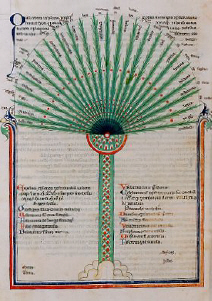15. Conferring – but how? As itself possessing them or not? How can it convey what it does not possess, and yet if it does possess how is it simplex? And if, again, it does not, how is it the source of the manifold?
A single, unmanifold emanation we may very well allow – how even that can come from a pure unity may be a problem, but we may always explain it on the analogy of the irradiation from a luminary – but a multitudinous production raises question.
The explanation is that what comes from the Supreme cannot be identical with it and assuredly cannot be better than it – what could be better than The One or the utterly transcendent? The emanation, then, must be less good, that is to say, less self-sufficing: now what must that be which is less self-sufficing than The One? Obviously the Not-One, that is to say, multiplicity, but a multiplicity striving towards unity; that is to say, a One-that-is-many.
All that is not One is conserved by virtue of the One, and from the One derives its characteristic nature: if it had not attained such unity as is consistent with being made up of multiplicity we could not affirm its existence: if we are able to affirm the nature of single things, this is in virtue of the unity, the identity even, which each of them possesses. But the all-transcendent, utterly void of multiplicity, has no mere unity of participation but is unity’s self, independent of all else, as being that from which, by whatever means, all the rest take their degree of unity in their standing, near or far, towards it.
In virtue of the unity manifested in its variety it exhibits, side by side, both an all-embracing identity and the existence of the secondary: all the variety lies in the midst of a sameness, and identity cannot be separated from diversity since all stands as one; each item in that content, by the fact of participating in life, is a One-many: for the item could not make itself manifest as a One-and-all.
Only the Transcendent can be that; it is the great beginning, and the beginning must be a really existent One, wholly and truly One, while its sequent, poured down in some way from the One, is all, a total which has participation in unity and whose every member is similarly all and one.
What then is the All?
The total of which the Transcendent is the Source.
But in what way is it that source? In the sense, perhaps, of sustaining things as bestower of the unity of each single item?
That too; but also as having established them in being.
But how? As having, perhaps, contained them previously?
We have indicated that, thus, the First would be a manifold.
May we think, perhaps, that the First contained the universe as an indistinct total whose items are elaborated to distinct existence within the Second by the Reason-Principle there? That Second is certainly an Activity; the Transcendent would contain only the potentiality of the universe to come.
But the nature of this contained potentiality would have to be explained: it cannot be that of Matter, a receptivity, for thus the Source becomes passive – the very negation of production.
How then does it produce what it does not contain? Certainly not at haphazard and certainly not by selection. How then?
We have observed that anything that may spring from the One must be different from it. Differing, it is not One, since then it would be the Source. If unity has given place to duality, from that moment there is multiplicity; for here is variety side by side with identity, and this imports quality and all the rest.
We may take it as proved that the emanation of the Transcendent must be a Not-One something other than pure unity, but that it is a multiplicity, and especially that it is such a multiplicity as is exhibited in the sequent universe, this is a statement worthy of deliberation: some further enquiry must be made, also, as to the necessity of any sequel to the First.
